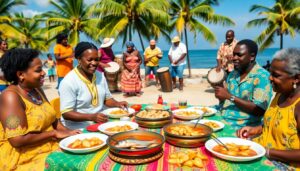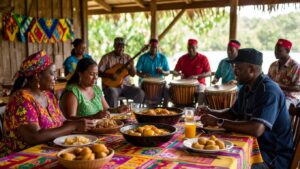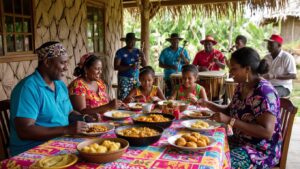Unveiling the Vibrant Garifuna Culture in Belize: Dive into Heritage, Culinary Treasures & Unique Experiences
The Garifuna community of Belize embodies a colorful blend of African, Indigenous Caribbean, and European cultural elements, resulting in a distinctive cultural legacy that garners international acclaim and recognition from UNESCO. Their diverse traditions encompass various facets, including language, music, culinary arts, dance, spiritual practices, and a profound sense of community. This comprehensive guide invites you to explore the enchanting story of the Garifuna in Belize, delving into their history, traditions, festivals, cuisine, and the vibrant cultural core of Hopkins Village.
Discovering the Essence of Garifuna Heritage
The Garifuna are celebrated as one of the most unique cultural groups in Belize, with a lineage tracing back to West and Central African ancestors, along with the Indigenous Caribs and Arawaks. After their resistance to colonial forces in St. Vincent in 1797, they were forcibly relocated to Central America. Currently, the Garifuna population in Belize is approximately 30,000, making substantial contributions to the cultural richness of southern Belize through their distinctive language, delectable cuisine, vibrant artistry, and rich customs. Recognized by UNESCO as a Masterpiece of the Oral and Intangible Heritage of Humanity, their enduring spirit, creativity, and adaptability thrive in communities such as Dangriga, Hopkins, Seine Bight, and Punta Gorda, as well as in diaspora communities across the Americas. The annual celebration of Garifuna Settlement Day on November 19th highlights their narrative of resilience, community, and vibrant cultural heritage.

Tracing the Historical Origins of the Garifuna People
Exploring the Ancestry of Africans and Caribs
The story of the Garifuna people originated in the 17th century with the extraordinary union of African survivors from two Spanish slave ships and the Indigenous Carib and Arawak inhabitants of St. Vincent in the Lesser Antilles. Over the following 150 years, intermarriage and cultural exchanges nurtured a unique Afro-Indigenous identity known as the Garinagu. This identity is characterized by a rich mosaic of traditions, languages, and practices that mirror their diverse ancestral heritages, illustrating a complex blend of cultural influences.
Courageous Exile and New Horizons in Belize
In 1797, after a fierce stand against British colonial forces, around 5,000 Garifuna were forcibly exiled from St. Vincent to Roatán, Honduras. This marked the onset of migrations that spread along the Central American coastline. By the early 19th century, lively Garifuna communities had taken root in southern Belize, particularly in culturally rich locales like Dangriga, recognized as the cultural capital, alongside Hopkins, Seine Bight, and Barranco. British authorities recognized these migrations, seeking skilled laborers adept in fishing and agriculture, which led to the flourishing of these communities.
Cultural Resilience and Continuity Over Time
Despite facing numerous adversities due to European colonization, land dispossession, and systemic discrimination, the Garifuna have remarkably preserved their language, social structures, and vibrant religious practices. The formation of the National Garifuna Council in 1981 has been instrumental in championing cultural rights and education, ensuring that the Garifuna legacy continues to be celebrated and acknowledged in contemporary society.
The Role of Language and Identity in Garifuna Culture
Distinctive Features of the Garifuna Language
The Garifuna language is classified as an Arawakan language, noted for its incorporation of Carib and African loanwords, rendering it a notable example among Central American languages. It showcases gendered pronouns, a complex tense system, and a rich array of oral traditions that encapsulate the community’s history and cultural values. However, the preservation of the Garifuna language faces significant threats from language shift due to migration and urbanization, with fewer than 15,000 Belizean Garifuna individuals still fluent.
Efforts for Revitalization and Preservation of the Garifuna Language
The designation of the Garifuna language and music as an Intangible Heritage by UNESCO in 2001 has spurred revitalization initiatives. In communities such as Hopkins and Dangriga, primary schools are now offering educational programs in Garifuna, while community radio stations broadcast news and music in the language, contributing to its preservation. Organizations like GAMAE International have launched language immersion summer camps aimed at rekindling youth connections with their ancestral roots and linguistic heritage.
Expressions of Identity and Global Community Connections
The Garifuna identity is strengthened through traditional clothing, ancestral lineage, clan totems, and unique naming customs. This identity is actively fostered by cultural associations both within Belize and in diaspora communities located in major cities such as New York, Los Angeles, and London, where they continue to honor and celebrate their rich heritage.
The Dynamic Realm of Garifuna Music and Dance
Intricate Rhythms and Spiritual Connections
Garifuna music is characterized by its complex rhythmic structures, harmoniously blending traditional African polyrhythms with indigenous chants. Central to numerous spiritual rituals and celebratory occasions, the drums—specifically the primero (tenor) and segunda (bass)—hold a crucial place. The sacred dugú ceremony exemplifies this connection, incorporating drum circles and ancestral invocations aimed at healing or blessing families, showcasing the profound relationship between music and spirituality within Garifuna culture.
Expressive Dance Styles: Punta and Punta Rock
One of the most renowned dance forms in Garifuna culture is the punta, which features rapid hip movements and intricate footwork, often accompanied by call-and-response singing and lively percussion. The modern evolution of this dance style, termed punta rock, has gained prominence through celebrated musicians like Andy Palacio and Pen Cayetano, who fuse traditional rhythms with contemporary instrumentation, thereby broadening the reach of Garifuna culture to audiences worldwide.
Cultural Festivals and Community Engagement
In the lively towns of Hopkins and Dangriga, dance troupes frequently perform during cultural festivals and for visiting guests, creating a vibrant connection between generations. These performances not only celebrate Garifuna heritage but also represent a significant economic resource for the community, fostering tourism and cultural interaction.

Understanding Garifuna Cultural Practices and Spiritual Beliefs
The Importance of the Dugú Ceremony
The dugú ceremony is a multi-day gathering where extended families unite to honor the spirits of their ancestors, referred to as gubida. Led by a spiritual healer known as buyei, the ceremony encompasses music, dance, and communal feasting, all aimed at restoring harmony within families and the wider community. It underscores a deep respect for the land, ancestral legacies, and collective responsibilities.
Daily Life and Spiritual Practices of the Garifuna
The spiritual beliefs of the Garifuna represent a unique amalgamation of Catholicism along with African and Arawak cosmologies. Daily routines are punctuated by various rituals, including blessings for new structures, rites of passage for births and deaths, and agricultural celebrations. Significant symbols, such as the conch shell, sea turtle, and cassava, create connections between households, the natural environment, and the ancestral spirits.
Exploring the Richness of Garifuna Cuisine and Gastronomy
Core Ingredients and Signature Culinary Creations
The culinary landscape of Garifuna culture is deeply anchored in staples like cassava (or yuca), plantains, coconut, and fresh seafood. Among traditional dishes, ereba stands out as a cassava bread crafted from grated cassava that is pressed and toasted over an open flame. Another signature dish, hudut, features fish simmered in creamy coconut milk, served alongside mashed green and ripe plantains. Machuca, a robust fish soup with garlicky, mashed plantain dumplings, and tapou, a savory seafood stew with coconut milk, are also beloved. In bustling street markets in Hopkins and Dangriga, visitors can indulge in local treats such as cassava pone (a sweet dessert), fried plantain balls (known as ganún), and refreshing conch ceviche.
Promoting Sustainable Culinary Practices
Traditional Garifuna approaches, including seasonal fishing, shellfish foraging, and small-scale farming, encourage ecological responsibility. These practices are informed by cultural taboos and principles of communal resource management. Culinary festivals held in Hopkins highlight cooking contests and food tours led by women’s cooperatives, ensuring the preservation of cherished recipes and culinary techniques while engaging visitors in the rich gastronomic traditions of the Garifuna.
Hopkins Village: The Heartbeat of Garifuna Culture
Historical Context and Cultural Significance
Established in the early 1800s and referred to as Yarumein in Garifuna, Hopkins lies along the scenic Stann Creek coast. It serves as a crucial hub for the Garifuna language, music, and crafts, embodying the rich cultural legacy of the community.
Must-Experience Attractions in Hopkins
- Drum Circles: Join in daily drum lessons and enjoy nightly drum circles at local cultural centers.
- Garifuna Museum: Discover artifacts, oral histories, and photographic exhibits that explore migration, language, and music.
- Homestays and Workshops: Connect with local families who provide cooking experiences, fishing excursions, and demonstrations of cassava bread making.
Annual cultural events in Hopkins, especially the youth pageants during Garifuna Settlement Day, establish the village as a genuine gateway to experiencing the vibrant cultural fabric of Garifuna Belize.
The Economic Impact of Cultural Tourism
Cultural tourism plays a pivotal role in Hopkins, sustaining over 75% of local families through accommodations, handicrafts, music workshops, and guided tours. The headquarters of the National Garifuna Council orchestrates regional festivals and advocacy efforts, ensuring that Garifuna culture remains vibrant and visible on the global stage.
Garifuna Settlement Day: A Celebration of Cultural Heritage
The Historical Importance of Settlement Day
Held each November 19 since 1941 and nationally acknowledged since 1977, Garifuna Settlement Day commemorates the significant arrival of Garifuna ancestors in Belize by canoe in 1802. The reenactment procession known as Yurumein sees villagers arriving ashore with drums, cassava, and crops amid joyful singing and prayers, representing their enduring legacy.
Modern Celebrations and Festive Activities
The celebrations of Garifuna Settlement Day seamlessly blend sacred and secular elements, featuring all-night dugú ceremonies and daylong drumming in churches and community squares. Processions adorned in traditional attire, vibrant parades, dance performances, and food fairs mark this special day. National broadcasts, media highlights, and diaspora festivities in major US cities attract visitors from all over Belize and beyond, fostering greater awareness and appreciation for Garifuna cultural traditions.
Contemporary Challenges and the Preservation of Cultural Heritage
The Shift in Language Among Younger Generations
Language shift represents a significant threat to the Garifuna community, as numerous young individuals, especially in urban environments, are increasingly speaking English or Kriol at home. UNESCO has recognized this alarming trend, prompting schools and NGOs to implement language immersion programs, radio broadcasts, and mentorship initiatives aimed at safeguarding linguistic heritage and cultural identity.
Land Rights and Tourism Development Concerns
The rapid growth of tourism and real estate development in coastal areas like Seine Bight and Hopkins jeopardizes the traditional landholdings of the Garifuna. Advocacy from the National Garifuna Council and collaborative NGOs focuses on securing land rights, influencing urban development, and ensuring that tourism revenues directly benefit local families and communities.
Engaging Youth through Arts, Technology, and Community Connections
Garifuna artists and musicians, both within Belize and in the diaspora, are actively recording music, documenting recipes, and preserving oral histories to develop digital archives and virtual festivals. These contemporary platforms are essential for fostering connections between the broader Garifuna community and younger generations, ensuring the vibrancy of their rich cultural heritage is celebrated and sustained.
Guidelines for an Authentic and Responsible Engagement with Garifuna Culture
- Select accommodations in Hopkins, Dangriga, or Seine Bight, and arrange tours directly with Garifuna-owned enterprises to support the local economy.
- Engage in a drum workshop, attend a Settlement Day celebration, or volunteer in local cultural preservation initiatives to immerse yourself in Garifuna culture.
- Support women’s cooperatives by tasting traditional dishes or purchasing handmade items to encourage sustainable livelihoods.
- Always respect local customs; seek permission before photographing individuals, and be considerate during rituals and ceremonies.
- Learn a few basic phrases in the Garifuna language to show respect and genuine interest in the culture.
The Garifuna culture in Belize represents a dynamic tapestry woven with resilience, profound spirituality, rhythmic music, delicious culinary offerings, and strong community bonds. By visiting places like Hopkins or Dangriga, participating in local festivals, or engaging with the pulsating rhythms of the drums, travelers have a unique opportunity to connect with a rich historical continuum where the past and present harmoniously coexist. Supporting Garifuna-owned businesses, honoring their traditions, and celebrating the linguistic and culinary diversity of this extraordinary culture are vital steps to ensuring its survival and flourishing for future generations.
References and Additional Resources for Further Exploration
- Language, Dance and Music of the Garifuna – UNESCO Intangible Heritage
- History Of The Garifuna People – Belize.com
- Garifuna people – Wikipedia
- Varner, G.R. “Native Status and Maya Identity in Belize.” Journal of Latin American Anthropology, 1998
- Lee, N.R. “Toledo Garifuna and Indigenous Rights.” Mesoamerican Research, 2022
- National Garifuna Council – Wikipedia
- The Garifuna Living Heritage – ICH NGO Forum, 2023
- Dinther, R. “Language Shift and Prestige: Garifuna in Hopkins.” Journal of Pidgin and Creole Languages, 2017
- Habinaha Garifuna Language Program
- Veal, T. “Africanisms in Garifuna Culture of Belize.” Cultural Anthropology, 2004
- National Geographic: Preserving Garifuna Identity Through Ritual
- Music In Africa: Punta Rock and Garifuna Music
- Hopkins Cultural Center Official Site
- Cultural Survival Quarterly: Maya Rainforest and Garifuna in Belize
- Belize Living Heritage: Rituals and Social Practices
- Texas A&M: Belizean Food Culture
- Love Your Belize: Hudut Recipe
- Global M&A Pages: Sustainable Fishing Cooperatives
- National Garifuna Council of Belize
- UN Sustainable Development Reports on Garifuna Cultural Tourism
- Ambergris Caye: Garifuna Settlement Day Celebrations
- Garifuna.com: Diaspora, Digital Storytelling, and Modern Initiatives
The Article Garifuna Culture in Belize: Heritage, Food & Where to Experience It appeared first on Belize Travel Guide
The Article Garifuna Culture: Experience Heritage and Cuisine in Belize Was Found On https://limitsofstrategy.com


